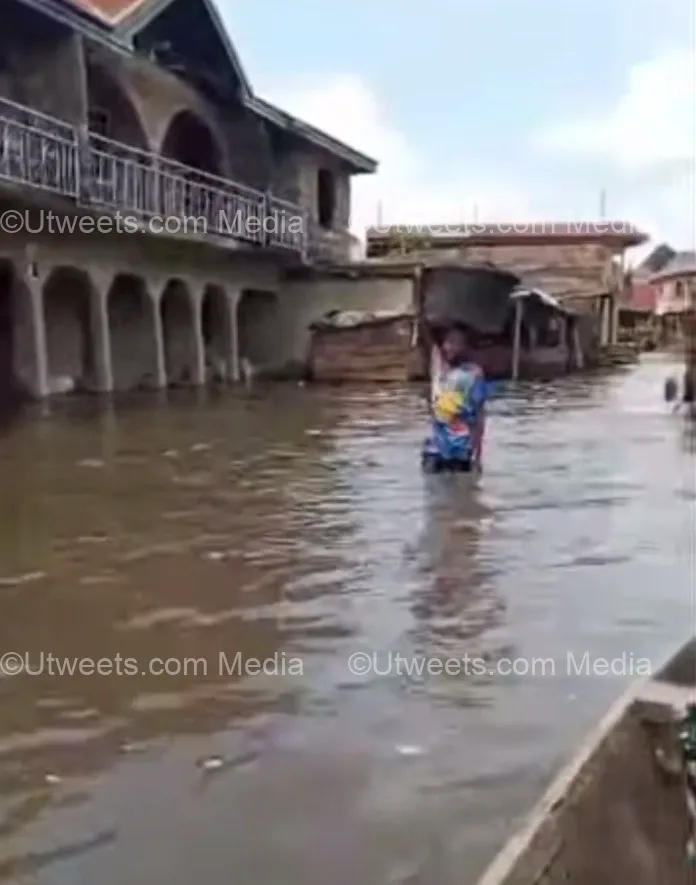Many houses located in flood-prone communities in five different local government areas across Anambra State have been submerged by flood following the rising water level from the River Niger and other related water activities. ...Tap To Read The Full Story Here | ..Tap To Read The Full Story Here...
Five local government areas have been affected by the flood including the Anambra West, Anambra East, Ogbaru, Awka North and Ayamelum local government areas.
Videos and pictures currently trending on social media show residents, including children wading through the waters, with submerged houses, markets, churches, schools, and other private and public facilities.
In one of the videos, a resident in one of the badly hit communities of Mmiata-Anam, Anambra West LGA, identified as Nnoru Anaekwe, narrated how residents of the community now paddle or ride in wooden canoes to their destinations, as major parts of the community and the local government area have been flooded.
One of the videos also showed when the Deputy Local Government Chairman of the Anambra West Local Government Area, Mrs Edith Ndive, was riding in a wooden canoe to her house.
Another video also captured some flood-submerged school buildings, as well as children paddling canoes and swimming in the flood.
In 2023 over 40 people reportedly died in a boat mishap that occurred along the Mmiata-Anam river, Anambra West LGA, when their boat hit a bridge and capsized in the waters.
The boat hit the bridge as a result of the rising water level. The victims of that tragedy were mostly women and children who were escaping to safer ground.
When contacted on the development, on Thursday, the State Commissioner for Environment, Felix Odimegwu, said the state government and relevant authorities were aware of the situation and were already providing necessary interventions.
Odimegwu said the water level had risen in the past few weeks, noting that the situation is being monitored.
He said, “The Anambra State Government Flood Management Team with personnel from NEMA, SEMA, International Organisation for Migration and the Red Cross Society are moving around collecting data on the situation at the Internally Displaced Persons camps.
“The state government has provided some interventions and relief materials so far to the people, with over 27 camps so far activated.
“No fewer than five local government areas have so far been affected by the flood, which include the Anambra West, Anambra East, Ogbaru, Awka North, and Ayamelum local government areas.”
According to him, the state government is better prepared for the flood, adding that the Ministry and the entire Flood Management Team have been issuing early warning signals almost every two days, showing the water level is rising.
The commissioner said the state received relief materials, including about 2,400 cartons of food items from Bank of Industries, adding that the food items comprised noodles, vegetable oil, Semovita, flour, salt and sugar.
He said these materials were distributed on Tuesday to the five local governments under threat at the moment.
Although he could not ascertain the total number of displaced persons so far, the commissioner said that the data were being generated, as the missions have been moving around the area since Tuesday.
He added, “Water level has risen in the past few weeks. We are monitoring the situation. Meanwhile a team of ANSG Flood Management Team with those from NEMA, SEMA, IOM, Red Cross, are moving around collecting data of the situation at the IDP camps.
“Because of early warning signals, we have been issuing out signals every two days displaying the water levels as it changes, we were better prepared. Many of the residents have moved to higher grounds and sorted shelter with their friends and relations. Others are at IDP camps.
“We have activated 27 camps. And the camps are ready to receive displaced persons as they come.
“The state has also received bags of beans, rice, noodles from Church of Jesus Latter Day Saints. These will be distributed any moment from now to the camps.
“The local government mayors are actively involved in making sure that adequate basic supplies are provided, that feeding is activated at the camps.”



